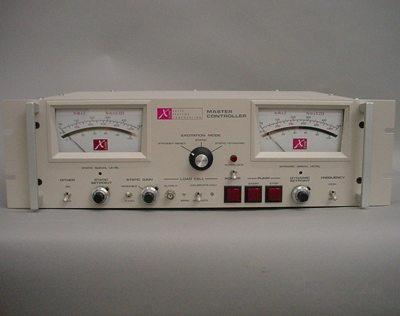Dual Loop Master Controller

The dual control loop design of the Xcite Master Controller affords three major advantages to the structural dynamist. First, the compression control of the dynamic loop changes the amplitude of the system drive signal dynamically to adjust the displacement output of the exciter to maintain a constant sine force even as the compliance of the structure changes during frequency sweeps.
This allows the study of non-linear structures by developing a family of data curves with varying levels of constant static and dynamic forces.
Second, the dual loop philosophy allows the mixture of feedback signals such as static displacement and dynamic force when testing compliant structures such as an automotive suspension or engine mounting subsystem. The static control may be force or displacement, while the dynamic control may be force, displacement, velocity or acceleration.
Third, a user selectable power amplifier input allows the dynamist to use either an external digital shaker control system or FFT analyzer DAC to drive the system with random, shaped random, white noise, chirp, pulse or user-generated waveforms. Master Controllers are rack-mountable and may be located hundreds of feet from the exciter head and power supply.
| Xcite Dual Loop Master Controller Statistics | |||
|---|---|---|---|
| Displays: | Pump Control | On/ Off | |
| Static Variable | Force or Displacement | Interlock | Interlock Connector for Ext. Signals |
| Dynamic Variable | Force or Displacement | Dither Control | 400 Hz On/ Off |
| Excitation Modes | Standby/ Static/ Static + Dynamic | Static Preload | Switch Selectable Tension or Compression |
| Control Variables: | Power Requirements | 115 VAC/ 3 A; 220 VAC/ 1.5 A | |
| Static | Force/ Displacement/ Ext. Transducer | Dimensions: | |
| Dynamic | Force/ Displacement/ Ext. Transducer | Width | 19 in (489 mm) Rack Mountable |
| Set Point Control | Static and Dynamic Setpoints | Depth | 13 in (330 mm) |
| Static Loop Gain | Fixed or Variable – Switch Selectable | Height | 5.25 in (133 mm) |
| Load Cell | Signal Conditioning and Calibration | Weight | 20 lbs (9 kg) |
| External Control Variable Calibration | User Adjustable Calibration for Static and Dynamic Variables | Inputs |
Program Input for Constant Amplitude Sine Testing External Power Amp Input for Random, Burst & Chirp |
| Frequency Modes: | Standby Level | User Adjustable Standby Force or Displacement Levels | |
| Low Frequency | Static Control Variable | LVDT | Signal Conditioning and Calibration |
| High Frequency | Static Control Variable + Compression Control of Dynamic Control Variable | Outputs | Force or Torque; Displacement; Dynamic Loop Compression Level |
